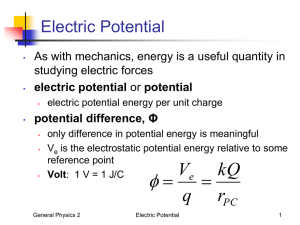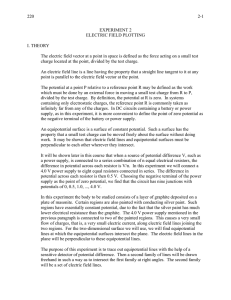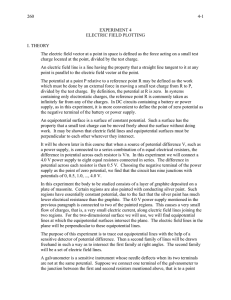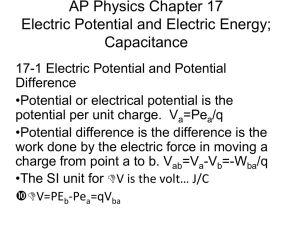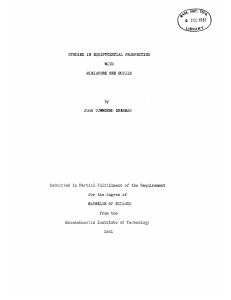Equipotential Surface Plotting Lab: Electric Fields
advertisement
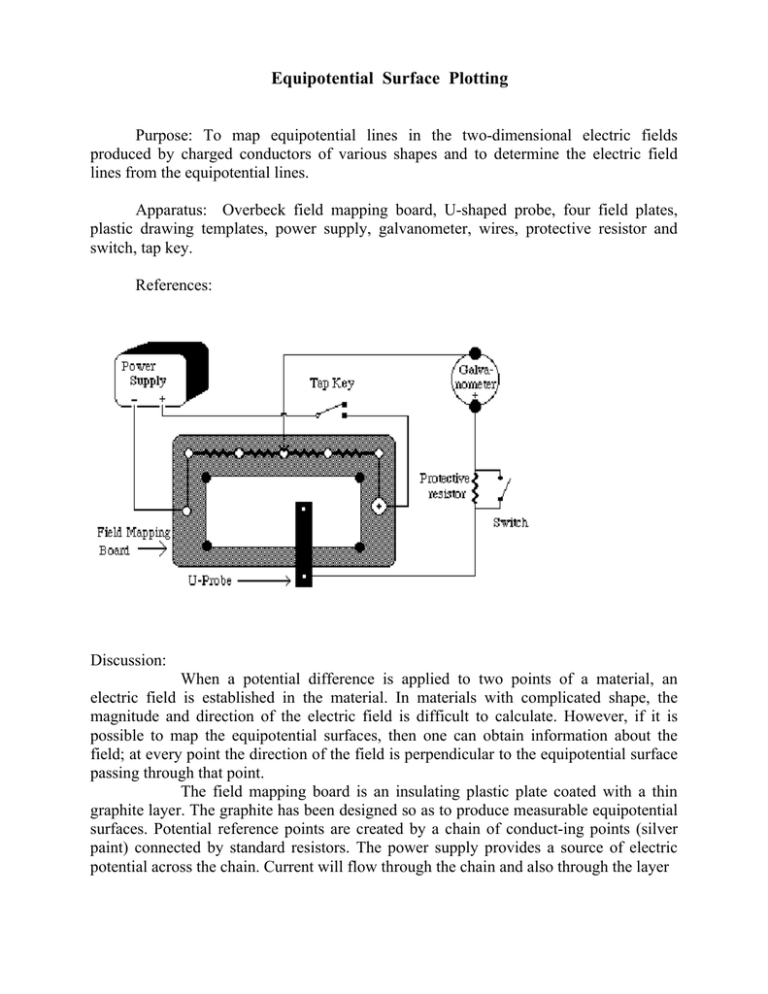
Equipotential Surface Plotting Purpose: To map equipotential lines in the two-dimensional electric fields produced by charged conductors of various shapes and to determine the electric field lines from the equipotential lines. Apparatus: Overbeck field mapping board, U-shaped probe, four field plates, plastic drawing templates, power supply, galvanometer, wires, protective resistor and switch, tap key. References: Discussion: When a potential difference is applied to two points of a material, an electric field is established in the material. In materials with complicated shape, the magnitude and direction of the electric field is difficult to calculate. However, if it is possible to map the equipotential surfaces, then one can obtain information about the field; at every point the direction of the field is perpendicular to the equipotential surface passing through that point. The field mapping board is an insulating plastic plate coated with a thin graphite layer. The graphite has been designed so as to produce measurable equipotential surfaces. Potential reference points are created by a chain of conduct-ing points (silver paint) connected by standard resistors. The power supply provides a source of electric potential across the chain. Current will flow through the chain and also through the layer of graphite. A two-dimensional electric field is created on the surface of the board, corresponding to a two-dimensional electric potential distribution. The equipotential surfaces for this distribution are curved lines. The highly conductive silver paint junction points between the resistors are good potential reference points. In order to map an equipotential line on the two dimensional surface, we use a standard "null" technique. The detector circuit consists of a galvanometer, a switch and a U-probe. When the potential at each end of the detector is identical, no current will flow through the galvanometer. The experiment involves locating points on the surface whose potential is equal to the potential at a particular silver junction point, thereby tracing out an equipotential line in the graphite layer. Procedure: Fasten field plate Number 1 to the bottom of the field mapping board, so that the surface with the pattern shows. Use the thumb screws on the bottom of the board. Note that pushing down on the board raises the four rubber retaining buttons on the top surface of the board. Fasten a sheet of 8½ x 11 inch paper to the board by slipping its edges under the retaining buttons. Place a transparent drawing template on the template guides and trace the outline corresponding to the pattern on the paper. Remove the template. Slide the U-probe over the mapping board. The arm with the hole in it should be over the board and the arm with the metal contact at the end should be under the board so the metal contacts the field plate's graphite surface. The hole in the top is directly above the lower contact point. Connect the power supply between the binding posts marked BAT or OSC on the board. Connect the red (positive) terminal of the power supply to the right side of the field board. Connect the positive terminal of the galvanometer to one side of the switch and the other side of the switch to the terminal of the U-probe, using a wire with a banana plug at one end and a spade lug at the other, connect the negative terminal of the galvanometer to jack E4 on the field board. Jack E4 is at a potential halfway between that of the electrodes on the field plate. With the switch open, start with the probe contact midway between the electrodes and move it slowly until the galvanometer reading is zero. Close the switch and rezero to get a more accurate measurement. Mark this position by making a circle with a pencil through the hole in the probe. Repeat the process until you have a series of points extending across the paper. Connect the points. This line represents the potential for potential E4. Move the banana plug from E4 to another jack and plot another equipotential in the same manner as above. Do this for all potentials, E1 to E7. Remove the paper and fasten a fresh sheet of paper on the board. Replace field plate Number 1 by plate Number 2. Trace its electrodes with the plastic template. Map the equipotential lines E1 to E7 as in the previous procedure. Repeat with field plate Number 3 and, if time permits, field plate Number 4. Electric Field Lines: Draw the field lines corresponding to the equipotential lines (with colored pencil if possible). The following physical facts may prove useful: 1. Field lines are continuous and everywhere perpendicular to equipotential lines. 2. Field lines are perpendicular to the surfaces or edges of conductors where they make contact. This is because a conductor is an equipotential. Make a complete set of field lines about 1 cm apart. Map 1 illustrates the field between two small, oppositely charged disks. Map 2 illustrates the field between parallel plates, as in a capacitor. Map 3 illustrates the field between a point charge and a conducting plate. Map 4 illustrates the field between as in Map 1, but distorted by a larger metal disk (conductor) and a dielectric disk (insulator).

